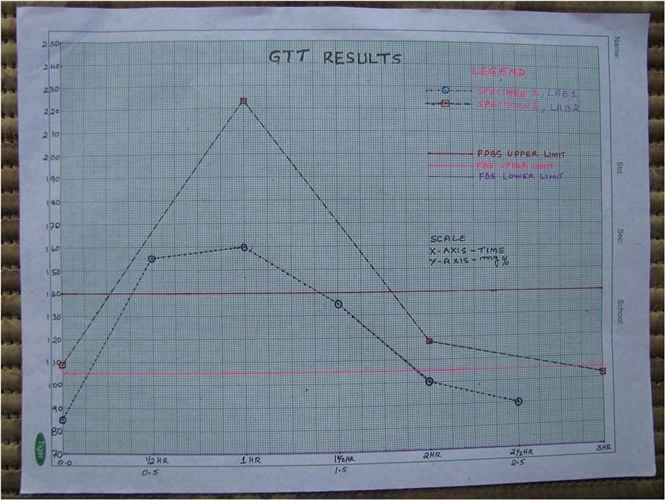OGTT
Oral Glucose Tolerance Ttest (OGTT) for pancreas is comparable to physicial efficiency/endurability test for recruitment to armed forces or similar services. As per some estimations 100 gms of cooked rice contains 30 gms of starch. I eat 300 gms of cooked rice or its equivalent of other items (like three Iddali/Idli, three Dosa/Doosa, Puttu, three Appam/Aappam etc) with side dishes thrice daily. This is a very moderate intake for age 64, height 172 cms (5' 8''), weight 60 kgs. Many people with identical conditions take double or more of this.
For an Oral Glucose Tolerance Test (OGTT) the subject is to consume a measured quantity of glucose at a stretch - within 5 minutes duration after confirming that baseline FBS is below 110 mg/dL (6.1 mmol/L). Intake of Glucose is calculated @ 1.75 grams for every kilogram of body weight, with a maximum of 75 grams (till 1975 it was 100 grams). Glucose being readily absorbable, enters blood stream instantaneously & applies heavy load on Pancreas (equivalent amount of strach if input as rice or other starchy food, will enter blood stream gradually due to the need of digestion to break the large Starch molecules into smaller Glucose molecules).
After this blood glucose is tested periodically and assessed; in the 75 gms case every half an hour five times & in the 100 gms case every one hour three times or as required by the consulting physician/surgeon.
If the final test result is less than or equal to 140 mg/dL (7.8 mmol/L) the subject is considered to be not diabetic.
OGTT is usually done to find out tendency towards diabetes or onset of diabetes; it is not done once diabetes is confirmed as Diabetes is popularly considered to be incurable. I decided to carry out OGTT in 2009, after having confirmed Diabetes in 2006 because I knew that Diabetes was cured in me bye then.
Read more at en.wikipedia.org/wiki/Gluco...
PICTURISATION OF MY OGTT RESULTS
The picture (graph) given above is drawn using the two OGTT results of mine. This was done for ease of understanding & comparison. The first test was done to confirm that my diabetes was cured, administering 75 grams of glucose & the second one was done to reconfirm cure, administering 100 grams of glucose. Former one was by GOD-POD methos & the latter one by Hexokinase method.
OMPARISON OF THE TWO OGTT RESULTS
The FBS is 85 mg/dL & 109 mg/dL respectively in the two tests. The maximum value is 160 mg/dL in the first case & 220+ in the second one. In the case of both the tests, at two hours from consumption of glucose, blood sugar results are below 120 mg/dL, the benchmark value being 140 mg/dL (7.8 mmol/L).
INTERPRETATION
The difference in FBS can be attributed to the different test methods (GOD-POD & Hexokinase) as well as the food intake of the intermediate days. The difference between the peak values at one hour is due to the difference in the glucose loading - 75 & 100 grams respectively. BUT THE IMPORTANT POINT TO BE NOTED IS THAT IN BOTH CASES, MY PANCREAS SUCCESSFULLY BROUGHT DOWN THE BLOOD SUGAR LEVEL BELOW THE BENCH-MARK VALUE OF 140 mg/dL AT 2-HOURS. That is what indicates the health & the regaining of NORMALCY of my pancreas with Long Wheat Mash Diet Regimen appropedia.org/Diabetes_mel... .
Lab report details of first OGTT are available at healthunlocked.com/diabetes... MYPOST2 OGTT1
& that of second one are at healthunlocked.com/diabetes... MYPOST3 OGTT2 .
==================================
Also please see
healthunlocked.com/diabetes... MYPOST PICTURE OF LONG WHEAT PACKET
healthunlocked.com/diabetes... MYPOST6
healthunlocked.com/diabetes... MY POST 1: Diabetes cured.
healthunlocked.com/diabetes... Long Wheat & Cure.
appropedia.org/Diabetes_mel... B S test results numerical representation
appropedia.org/Diabetes_mel... B S test results graphical representation
appropedia.org/Diabetes_mel... Pictures for comparison, Preparing LWM
appropedia.org/Diabetes_mel... Caution
appropedia.org/Diabetes_mel... Name in different languages
appropedia.org/Diabetes_mel... Pit-falls The pit- falls.
appropedia.org/Diabetes_mel... Some other patients.
